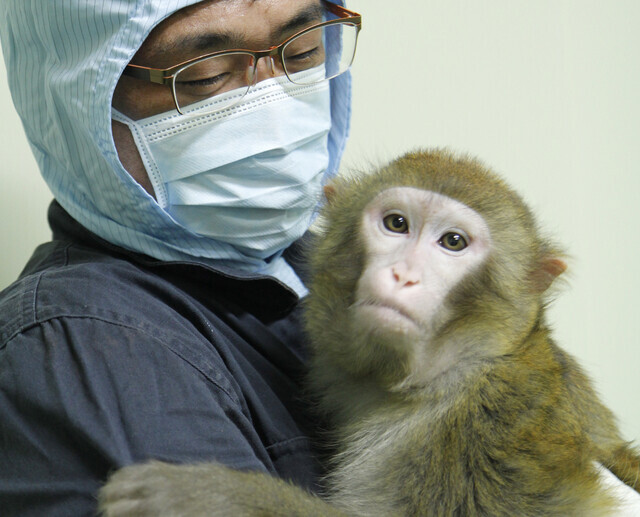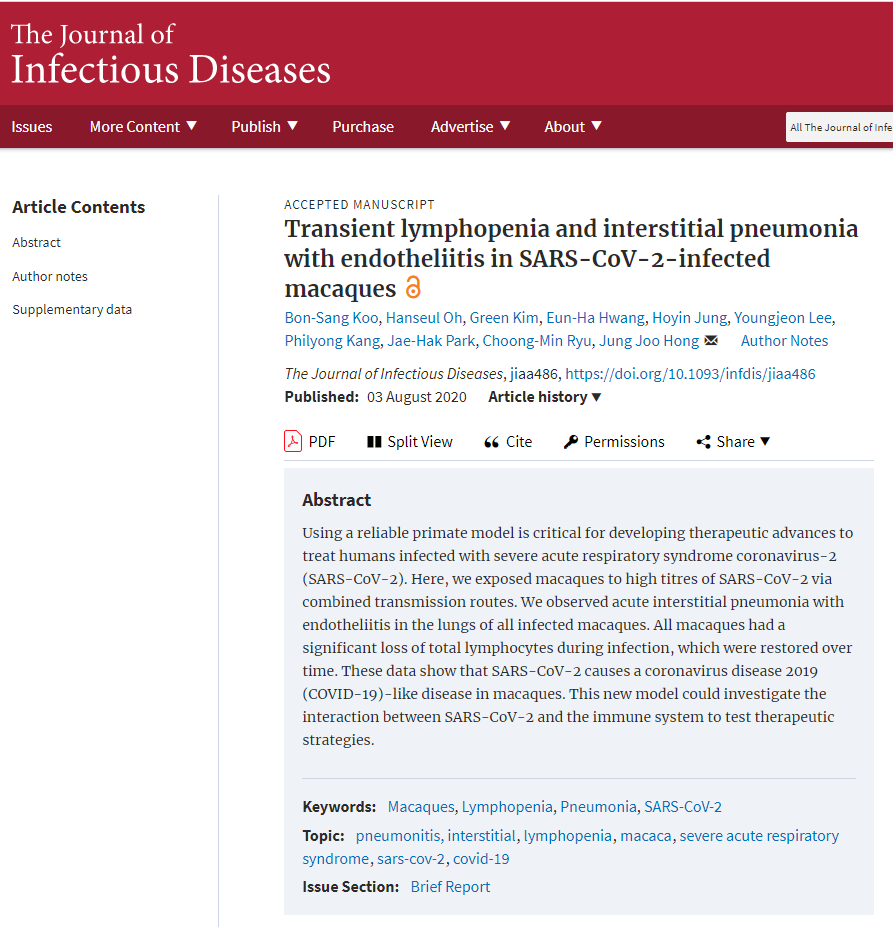hankyoreh
Links to other country sites 다른 나라 사이트 링크
S. Korean researchers show COVID-19 causes inflammation in both organs and blood vessels

A team of South Korean researchers has become the first to show through animal testing that the virus causing COVID-19 causes inflammation not only in the respiratory organs but also in the blood vessels.
The Korea Research Institute of Bioscience and Biotechnology (KRIBB) announced on Aug. 5 that a research team led by Hong Jung-joo had demonstrated for the first time that SARS-CoV-2 causes vascular inflammation and provokes immunosuppression in an experiment using nonhuman primate models. Hong is a senior research fellow at KRIBB’s Korea National Primate Research Centre, as well as a professor at the veterinary college at Chungnam National University.

Back in February, the research team began raising primate models that could be used for developing medications and vaccines for COVID-19. The team was the fourth to successfully raise such models, following other efforts in China, the Netherlands, and the US.
A nonhuman primate model is a primate test subject that is selected to present similar clinical symptoms as humans when infected with a pathogen. The models selected by the Korean research team were rhesus macaques and crab-eating macaques, which were infected with the virus via the nose and mouth, just as humans are.
Through observation of the monkeys’ behaviors and symptoms and diagnosis of the state of their infection, the researchers found that the virus caused vascular inflammation. This is the first time that such inflammation has been detected. The blood vessels remained inflamed for three days after infection.
For two days after infection, when the virus was rapidly proliferating, the monkeys presented the kind of immunosuppression that is observed in patients suffering from immunodeficiency.
Research may offer clues behind asymptomatic infectionAnother observation was that the virus rapidly proliferated in monkeys’ necks and lungs for two days after infection and then sharply declined for seven days until no active viruses could be detected.
“This will provide some clues for explaining the issue of false positives, in which patients test positive for COVID-19 at the time of diagnosis but do not present any symptoms of infection,” the research team said.
In more than 80% of the monkeys that were tested, body temperature rose as a symptom of acute infection, along with marked propagation of the virus in the upper airway and lungs. All the animals that were tested developed interstitial pneumonia (a disease in which the walls of the alveoli are inflamed). None of the cases were fatal, but symptoms were severe, rather than mild.
All test subjects were also observed to have inflammation of the endothelium, the lining of the blood vessels. During the acute period, when the virus is most active, researchers observed an overall decrease in the levels of lymphocytes (a subtype of white blood cells that play a role in the immune system) in the bloodstream.
“Most of the macaques in both species passed through an acute period of infection before beating the disease. That seems to model human recovery from COVID-19 after infection,” the research team said. “The primate model provides important clinical information about bodily changes during the early acute infection phase, which is difficult to study in human patients.”
The paper was selected to be the cover article for the Journal of Infectious Diseases; it was posted online on Aug. 3.
By Lee Keun-young, staff reporter
Please direct comments or questions to [english@hani.co.kr]

Editorial・opinion
![[Editorial] Intensifying US-China rivalry means Seoul must address uncertainty with Beijing sooner than later [Editorial] Intensifying US-China rivalry means Seoul must address uncertainty with Beijing sooner than later](https://flexible.img.hani.co.kr/flexible/normal/500/300/imgdb/original/2024/0517/8117159322045222.jpg) [Editorial] Intensifying US-China rivalry means Seoul must address uncertainty with Beijing sooner than later
[Editorial] Intensifying US-China rivalry means Seoul must address uncertainty with Beijing sooner than later![[Column] When ‘fairness’ means hate and violence [Column] When ‘fairness’ means hate and violence](https://flexible.img.hani.co.kr/flexible/normal/500/300/imgdb/original/2024/0516/7417158465908824.jpg) [Column] When ‘fairness’ means hate and violence
[Column] When ‘fairness’ means hate and violence- [Editorial] Yoon must stop abusing authority to shield himself from investigation
- [Column] US troop withdrawal from Korea could be the Acheson Line all over
- [Column] How to win back readers who’ve turned to YouTube for news
- [Column] Welcome to the president’s pity party
- [Editorial] Korea must respond firmly to Japan’s attempt to usurp Line
- [Editorial] Transfers of prosecutors investigating Korea’s first lady send chilling message
- [Column] Will Seoul’s ties with Moscow really recover on their own?
- [Column] Samsung’s ‘lost decade’ and Lee Jae-yong’s mismatched chopsticks
Most viewed articles
- 1[Editorial] Transfers of prosecutors investigating Korea’s first lady send chilling message
- 2[Column] US troop withdrawal from Korea could be the Acheson Line all over
- 3[Column] When ‘fairness’ means hate and violence
- 4China calls US tariffs ‘madness,’ warns of full-on trade conflict
- 5Major personnel shuffle reassigns prosecutors leading investigations into Korea’s first lady
- 6[Editorial] Yoon must stop abusing authority to shield himself from investigation
- 7Could Korea’s Naver lose control of Line to Japan?
- 8[Editorial] Korea must respond firmly to Japan’s attempt to usurp Line
- 9US has always pulled troops from Korea unilaterally — is Yoon prepared for it to happen again?
- 10[Column] Welcome to the president’s pity party